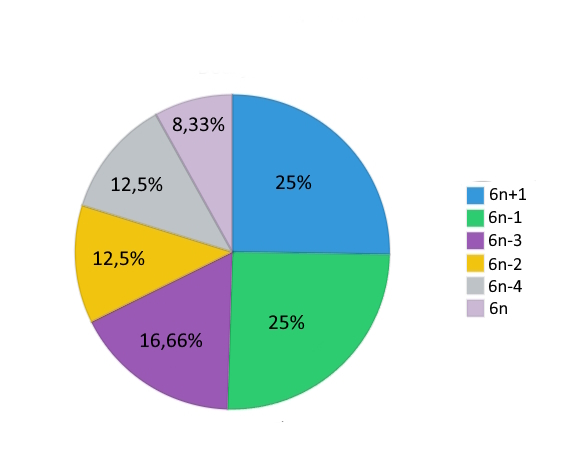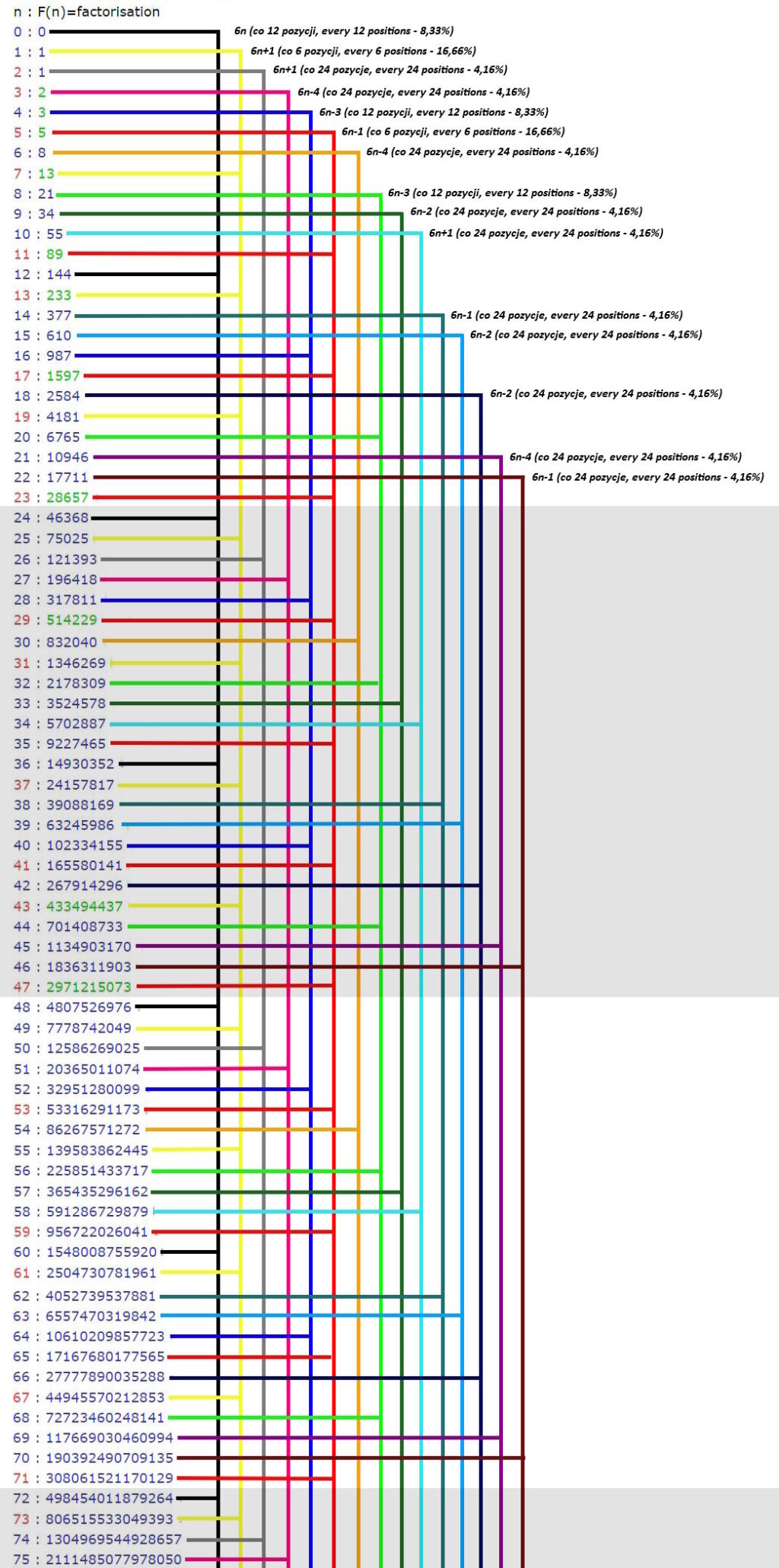The Fibonacci number sequence is one of the most famous and recognizable number sequences in mathematics. Each number in the sequence is the sum of the previous two: 0, 1, 1, 2, 3, 5, 8, 13, 21, 34, 55, and so on. This sequence has many interesting applications in mathematics, computer science and other fields, including in the analysis of algorithms, graph theory, cryptography and statistics. An interesting aspect of the Fibonacci sequence is the ratio of consecutive numbers, which tends to a constant value called the Golden Section (Golden Section) or the Golden Number. The Golden Ratio is denoted by the Greek letter φ (phi) and is approximately 1.618033988749895.
I will try to present it from a completely different perspective. First, let’s assume that all natural integers, including those from the Fibonacci sequence, can be obtained from six basic formulas such as:
6n, 6n+1 where n>=0 and 6n-4, 6n-3, 6n-2, 6n-1 where n>0.
If you already know my theories on how prime numbers are formed, you will quickly notice that the formulas 6n+1 and 6n-1 form all prime numbers (except 2 and 3) and near-prime numbers (i.e. products of two prime numbers except 2 and 3). (For more on near-prime numbers, see PRIME NUMBERS CODE).

The surprising fact is that the numbers from the Fibonacci sequence belonging to the formulas 6n+1 and 6n-1 account for 50% of all the numbers in the infinite Fibonacci sequence.
Each number from the Fibonacci sequence with the index of a prime number or a near-prime number is always included in the set of numbers from the two formulas 6n+1 and 6n-1.
25% of the Fibonacci numbers are in the 6n+1 set.
From the index of the 1st Fibonacci number (1) they occur every 6 positions, which is 16.66%, from the index of the 2nd Fibonacci number (1) they occur every 24 positions, which is 4.16%. Every 24 positions from the index of the 10th Fibonacci number (55) is another 4.16%.
25% of the Fibonacci numbers are in the 6n-1 set.
From the index of the 5th Fibonacci number (5) they occur every 6 positions, which is 16.66%, from the index of the 14th Fibonacci number (377) they occur every 24 positions, which gives us 4.16%. Every 24 positions starting from the 22nd position of the Fibonacci sequence index (17711) is another 4.16%.
12.5% of the Fibonacci numbers are in the 6n-4 set.
Every 24 index items of the 3rd Fibonacci number (2) – 4.16%, every 24 positions of the index 6th Fibonacci number (8) – 4.16%, every 24 positions of the index 21st Fibonacci number (10946) – 4.16%.
12.5% of the Fibonacci numbers are in the 6n-2 set.
Every 24 index positions of the 9th Fibonacci number (34) – 4.16%, every 24 positions of the index 15th Fibonacci number (610) – 4.16%%, every 24 positions of the index 18th Fibonacci number (2584) – 4.16%.
16.66% of the Fibonacci numbers are in the 6n-3 set.
Every 12 positions from the index of the 4th Fibonacci number (3) – 8.33% and every 12 positions from the index of the 8th Fibonacci number (21) – 8.33%.
However, for some reason, the Fibonacci sequence avoids 6n numbers very much, which is a multiple of 6.
Numbers from the 6n set occur only every 12 positions starting from the 0th index of the Fibonacci sequence 0), which gives us only 8.33%.
In general, the Fibonacci sequence consists of 50% of prime and near-prime numbers.
As you can see in the picture below, the Fibonacci sequence creates a 24-element sequence of numbers belonging to the above-mentioned formulas.

It can be said that looking at the Fibonacci sequence, we notice the dependence that the further it progresses, the fewer prime numbers there are in it and more and more near-prime numbers. The conclusion that comes to mind is that prime and near-prime numbers are the key point of reference in understanding all areas of our lives where the Fibonacci sequence is applicable and mapped.
However, in the Fibonacci sequence (from the first position in the index of the Fibonacci sequence) the 24-element sequence of sums of digits of each number is repeated systematically.
Example; the sum of the digits of the number 377 is 8 because 3+7+7=17, calculating further is to 1+7=8.
An interesting observation is also the fact that the sum of the two previous “sums of digits” of Fibonacci numbers is equal to the sum of the digits of the next Fibonacci number,
e.g. 13+21 or (1+3)+(2+1)=4+3=7
so the sum of the digits of the next number, which is 34 (or 3+4), is 7. Generally, we reduce the sum of the digits of each number to a single-digit value in the range from 1 to 9. As we can see in the figure below.

A 24-element repeating sequence of sums of digits in the Fibonacci sequence of numbers (counting from the 1st index (1)) is decomposed in the following order:
1,1,2,3,5,8,4,3,7,1,8, 9,8,8,7,6,4,1,5,6,2,8,1,9.
Prime numbers in the Fibonacci sequence (from 5 positions of its index (5)) always have a sum of digits of 1, 4, 5 or 8.
Therefore, in the Fibonacci sequence (from 5 positions of its index (5)) there are no prime numbers whose sum of digits is 2 and 7 (because numbers with the sum of digits 2 and 7 occur in the Fibonacci sequence on an index with an even value, and we assume that numbers with index other than the index of a prime number (which are odd) in the Fibonacci sequence cannot assume the value of a prime number).
In addition, a prime number in the Fibonacci sequence (from 5 positions of its index (5)) can only be a number whose value of the sum of the digits of the previous number is 1, 3, 6, 8 or 9. This property is very helpful in finding and factoring subsequent prime numbers in the Fibonacci sequence.
More than 20.83% of the numbers in the Fibonacci sequence have a sum of digits equal to 1.
The next 20.83% of the numbers in the Fibonacci sequence have a sum of 8 digits.
After 8.33%, they get the sums of the digits: 2, 3, 4, 5, 6, 7 and 9.
The Fibonacci sequence consists of 66.66% odd numbers and only 33.33% of even numbers.
From the index of the third number in the Fibonacci sequence, every 3 positions are even numbers.
Statistically, there are more prime numbers in the Fibonacci sequence that are in the set 6n-1.
